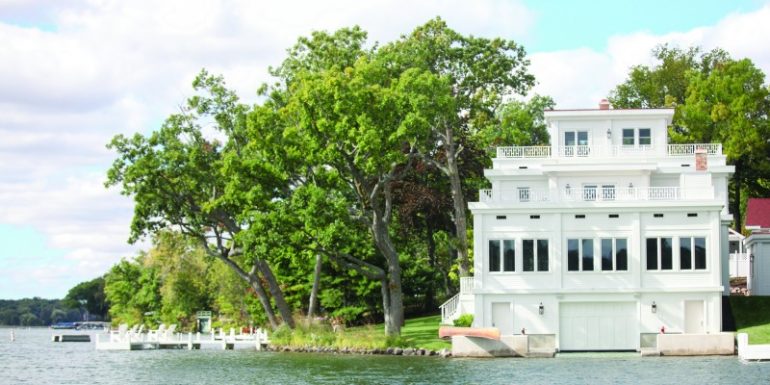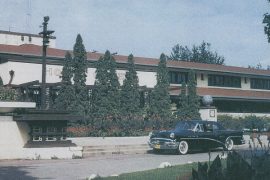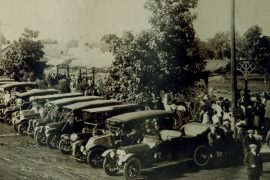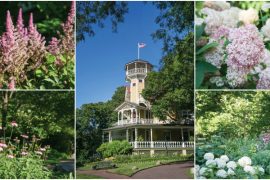By Anne Morrissy | Photography By Shanna Wolf
In 2003, Jeff Adams and his wife were living in Barrington, Ill., with their kids when they decided they’d like to invest in a small summer getaway home. Jeff worked in wealth management and traveled quite a bit for his job, so they began a methodical search of lake communities that were within a two-hour drive of Barrington. After looking at several lakes in southern Wisconsin and northern Illinois, the Adamses chose the Lauderdale Lakes, just north of Elkhorn, which are really a chain of three lakes: Mill Lake, Middle Lake and Green Lake, along with a bay called Don Jean Bay. Jeff’s middle name is Lauderdale, but at the time he thought that was just an amusing coincidence.
“We picked the Lauderdale Lakes because of all the activities here—skiing, fishing, boating, swimming…” Jeff says. “When we finally went through that process of elimination, Lauderdale had everything we wanted: it’s spring fed, it’s a family lake. And because it’s really three lakes connected, everybody has their place in terms of which activities they prefer—the lake flows with activity.”
Not long after they had purchased their first summer home there, Jeff discovered his connection to the Lauderdale Lakes went back much further than he knew. “A couple years later, we made the connection that my middle name was more than a coincidence,” he explains. Jeff’s middle name came from his grandmother’s maiden name, and he discovered that his grandmother was born in the area, a descendant of the Lauderdale family for whom the lakes were originally named. (The Lauderdales were some of the earliest settlers of that part of Walworth County, and they bought most of the farmland on the east side of the lakes, hence the name.)
Jeff had inadvertently chosen the one lake (or really, three lakes) that his ancestors had lived on for generations. And much like his ancestors, Jeff and his family found they loved living on Lauderdale. So in 2009 when an historic home came up for sale on Deakin Island between Middle and Green Lakes, the Adamses decided to take on a new project: The Boat House.
CAPTURING THE IMAGINATION
The Adamses had their eye on the Boat House long before they purchased it. In fact, the historic home is hard to miss; it has an enormous cement wet dock built out into the lake, a relic of the early 20th century when the home’s owner, a world-class speedboat racer, kept his prized racing boats on Lauderdale. Adams’ wife Kelly has a design degree from the University of Texas and her passion is architecture. “We watched the person whose house is next door as they restored their home,” says Adams. “The idea of restoring the Boat House just captured our imagination. The house next door was the parents’ house, and the house we have is the house they gave their son. It just kind of piqued our interest.”
The more they learned about the Boat House, the more interesting it became. The distinctive home was built in stages, with the earliest portion dating to the 1880s, when it was a small Eastlake-style cottage used by Judge Charles Bishop. By the early 1900s, Bishop sold his cottage to James and Julia Deakin who owned most of the land on the island (and gave it their name). The Deakins lived next door to the cottage in a Victorian home called Lakeview. When their son, Earl Deakin, graduated from the Lewis Institute in Chicago (now part of the Illinois Institute of Technology) in 1906 and married Florence McCutcheon of Whitewater, the elder Deakins gave the cottage to the newlyweds.
James Deakin made his fortune in the importing, wholesale and retail sale of fine art, particularly art of Japanese origin. When Earl and Florence decided to expand and improve the cabin on Lauderdale after their wedding, they incorporated elements from James Deakin’s imported art business throughout the house.
THE PLAYBOY, THE SPEEDBOAT, AND THE OPIUM DEN
By the time of his marriage to Florence, Earl had already earned a reputation as a thrill-seeking playboy. His first passion was speedboat racing; his hydroplane boat “Hydro Bullet” could reach almost 50 mph and won several national speed competitions. He was also an early adopter of automobiles, registering as one of only 300 “automobilists” in Chicago in 1902 and taking his new bride on an Eastern road trip for their honeymoon four years later.
Returning from their honeymoon in 1906, Earl and Florence set to work on the cabin, adding a large ballroom, the boat house and wet dock for Earl’s boats and a garage for Earl’s cars. Earl’s friendship and business connections with Chicago native and Broadway impresario Flo Ziegfeld, whose famous Follies would premiere on Broadway in 1907, influenced the design of the ballroom. According to Jeff’s research, the ballroom floor was made of a resilient rock maple wood, and Deakin installed dance mirrors for use by Ziegfeld’s dancers who would practice and entertain in the ballroom during parties. Earl Deakin also added an opium den off the ballroom and incorporated a private swimming pool into the design of the wet boat house, a nod to his hobbies and the high-gloss company he kept.
As their family expanded, Earl and Florence added a second and third floor above the garage in 1913 with more bedrooms and private space. However, they continued to throw famous parties throughout the Prohibition era. When Adams started researching the history of the house, he says he heard a lot of oral histories from long-time residents of the area about the well-known Chicago gangsters of the era visiting the house, including Al Capone himself. Although Adams could not definitively confirm those rumors, he says that during the demolition and reconstruction of the house, they did discover a hidden room big enough to fit three people, as well as evidence of a hidden escape route that led directly to the boat basin to allow for a quick getaway during a police raid.
Sadly, Earl Deakin was badly burned in a boating accident in 1924 at one of his beloved speedboat competitions. He became increasingly addicted to narcotics and began to succumb to mental illness, eventually becoming convinced that the Japanese were going to invade Wisconsin in the build-up to World War II. He passed away in 1944, and the Lauderdale house was sold.
A NEW BLUEPRINT FOR AN OLD HOUSE
By the time the Adamses bought the house in 2010, it had gone through many owners and several alterations. The Adams’ initial plan was to restore the home to its original heyday of 1915-1920, but the more they researched, the more roadblocks they came across. “We quickly sobered up to the fact that based on the [Wisconsin Department of Natural Resources] rules, and there were some really crazy rules, that this was going to be a lengthy project,” Adams explains. They began researching the history of the house to apply for historic status, which would have allowed them to bypass the DNR rules. Unfortunately, the house had been altered too much to receive the historic designation. Then suddenly in the middle of that process, DNR management changed hands and the rules were relaxed, allowing the Adams’ plans to move forward.
“We thought we were going to peel back just a couple of layers and restore it,” Jeff explains. “But with each layer we pulled back, we had to keep going.” When they lifted the house to repair the foundation, they discovered that a whole new foundation was necessary. What they had hoped would be an upgrade of the electrical system had to be a complete replacement of the electrical system. Eventually it became clear that a historic restoration would be nearly impossible; what the project called for was a historic reconstruction. So they set about salvaging everything they could from the old house, including the rock maple ballroom floor, the vintage imported Japanese light fixtures from the Meiji period and the Eastlake-era pocket doors with vintage hardware.
They asked community members to share any historic photos of the house they might have and used those photos as well as oral histories to draw up a new blueprint for an old house. Adams even invited Julie Hansen Branks, whose parents owned the house from the 1940s through the 1960s, to walk through and share her memories of the home during that period, so they could get the second- and third-floor bedroom configuration just right.
The wet dock and boat house presented a unique challenge. “First we drained it and dredged it and tried to get rid of that split pea soup muck that was in it,” Adams remembers. “We uncovered steps and ledges that were finished out like a swimming pool and that’s when we learned that was their private party pool. Then underneath the house and the ballroom, there were a lot of old hoists and pulley systems that were deep down in the muck and beams. There was a kind of a manual pulley system for hoisting up three boats. We ended up removing 4.5 feet of muck, dirt and rocks. What was amazing was that we had the benefits of modern 18-foot-tall pilings and big Caterpillar machinery to put the pilings in place, we had electric pumps to clean out the basin and it still took us six months to get that thing cleaned out.”
They then hired a marine contractor to pour a new cement basin to replace the cracked one. “Being able to restore the boat basin … we didn’t know up until the last moment whether we were going to be able to accomplish that,” Adams says. But in the end, the project was a success.
A COMMUNITY PROJECT, NOW READY FOR THE FUTURE
After six long years of research, salvage and reconstruction, the Adamses finally moved into the house this spring. But the true crowning moment of the project was when they christened the house at the end of summer 2015 by using it as the venue for their daughter’s wedding. “It became public knowledge that one of our self-imposed deadlines was our daughter’s wedding last August,” Adams explains. “I remember when she and I came out of the house to come down to the pier for the wedding, the minute we turned the corner and she got her first view of the wedding party and the people waiting for her, there were probably 30 boats anchored around the pier that were just neighbors and supporters who came out to see the wedding. I think it was an example of community connection to the house. They had watched it go down, watched it come back up and they wanted to be a part of this event.”
In fact, Adams credits the community and the many skilled workers around the area who worked on the house over six years for the successful reconstruction of the Boat House. “We couldn’t have done it without the support of the community and local businesses,” he says. When asked to name his favorite thing about the house, he pauses: “Preserving that piece of history and that extension of past generations, whether it was the people who owned it or lived there or went to parties there. To have it be much bigger than any one owner. We don’t really think of ourselves as owners, we’re the stewards, this generation’s caretaker of the property. Hopefully now it’s ready for the next 100 years.”





